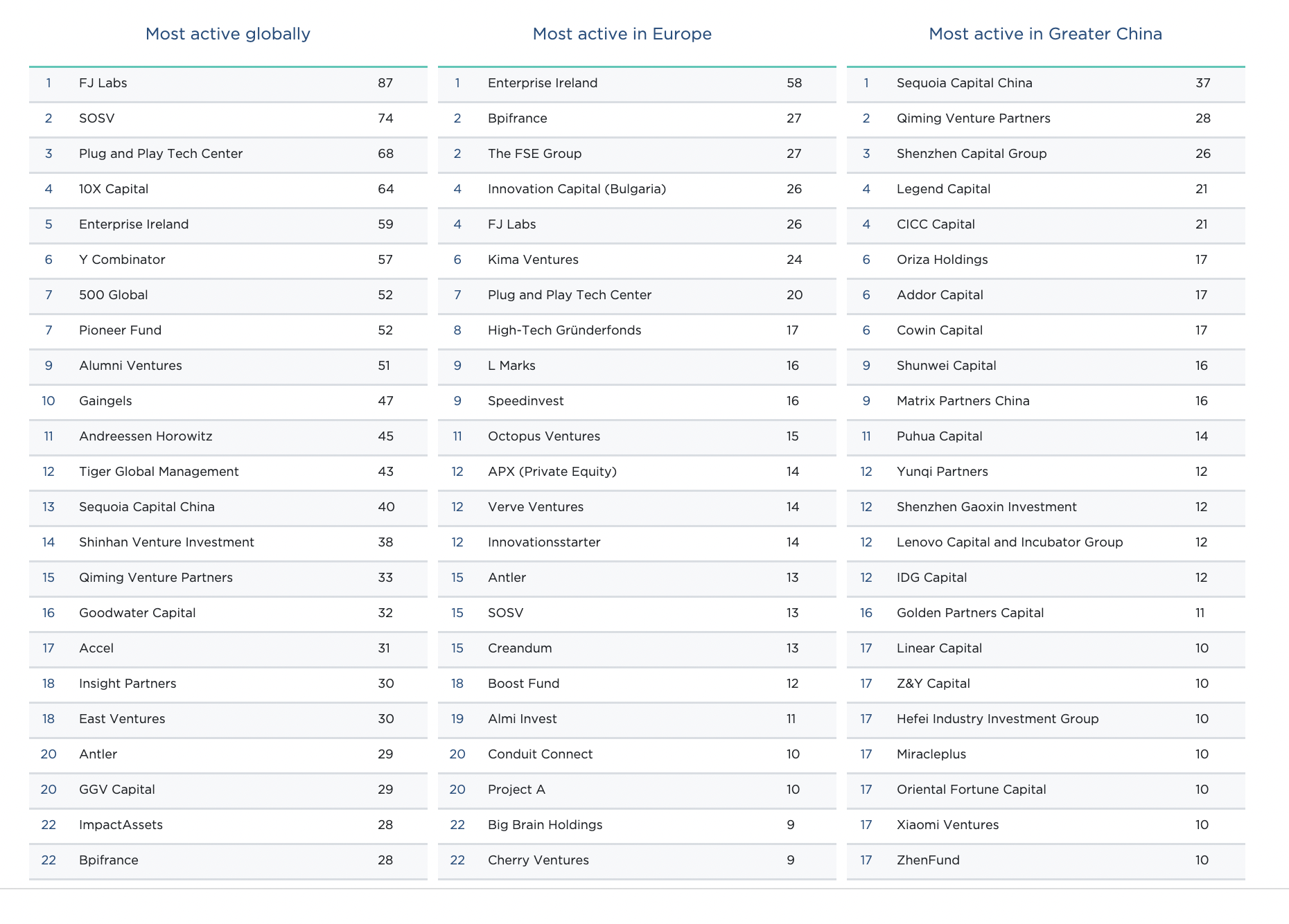Yesterday, we had the chance to catch up with Fabrice Grinda, a serial entrepreneur who co-founded the free classifieds site OLX — now owned by Prosus — and who has in recent years been building up his venture firm, FJ Labs. He often likens the outfit to an angel investor “at scale,” saying that like a lot of angel investors, “We don’t lead, we don’t price, we don’t take board seats. We decide after two one-hour meetings over the course of a week whether we invest or not.”
The outfit, which Grinda co-founded with entrepreneur Jose Marin, has certainly been busy. Though its debut fund was relatively small — it raised $50 million from a single limited partner in 2016 — Grinda says that FJ Labs is now backed by a wide array of investors and has invested in 900 companies around the world by writing them checks of between $250,000 and $500,000 for a stake of typically 1% to 3% in each.
In fact, the data provider PitchBook recently ranked FJ Labs the most active venture outfit globally, just ahead of the international outfit SOSV. (You can see Pitchbook’s rankings at page bottom.)
Yesterday, Grinda suggested that the firm could become even more active in 2023, now that the market has cooled and founders are more interested in FJ Lab’s biggest promise to them — that it get them follow-on funding come hell or high water through the connections of Grinda and his partners. Indeed, while that promise was probably less interesting in a world awash with capital, it has likely become more compelling as investors pull back and founders find themselves facing fewer options. Excerpts from our wide-ranging chat with Grinda follow, edited lightly for length.
TC: You’re making so many bets in exchange for a very small stake. Meanwhile you’ve bet on companies like Flexport that have raised a lot of money. You’re not getting washed out of these deals as they raise round after round from other investors?
FC: It’s true that you sometimes go from 2% to 1% to 0.5%. But as long as a company exits at 100 times that value, say we put in $250,000 and it becomes $20 million, that’s totally fine. It doesn’t bother me if we get diluted on the way up.
When making as many bets as FJ Labs does, conflicts of interest seem inevitable. What’s your policy on funding companies that might compete with one another?
We avoid investing in competitors. Sometimes we bet on the right or the wrong horse and it’s okay. We made our bet. The only case where it does happen is if we invest in two companies that are not competitive that are doing different things, but one of them pivots into the market of the other. But otherwise we have a very Chinese Wall policy. We don’t share any data from one company to the others, not even abstracted.
We will invest in the same idea in different geographies, but we will clear it by the founder first because, to your point, there are many companies that attract the same markets. In fact, we may not take a call when a company is in the pre-seed or seed-stage or even A stage if there are seven companies doing the same thing. We’re like, ‘You know what? We’re not comfortable making the bet now, because if we make a bet now, it’s our horse in the race forever.’
You mentioned not having or wanting board seats. Given what we’re seen at FTX and other startups that don’t appear to have enough experienced VCs involved, why is this your policy?
First of all, I think most people are good-intentioned and trustworthy so I don’t focus on protecting the downside. The downside is that a company goes to zero and the upside is that it goes to 100 or 1,000 and will pay for the losses. Are there cases where there has been fraud in lining the numbers? Yes, but would I have identified it if I sat on the board? I think the answer is no, because VCs do rely on numbers given to them by the founder and what if someone’s giving you numbers that are wrong? It’s not as though the board members of these companies would identify it.
My choice not to be on boards is actually also a reflection of my personal history. When I was running board meetings as a founder, I did feel they were a useful reporting function, but I didn’t feel they were the most interesting strategic conversations. Many of the most interesting conversations happened with other VCs or founders who had nothing to do with my company. So our approach is that if you as a founder want advice or feedback, we are there for you, though you need to reach out. I find that leads to more interesting and honest conversations than when you’re in a formal board meeting, which feels stifled.
The market has changed, a lot of late-stage investment has dried up. How active would you say some of these same investors are in earlier-stage deals?
They’re writing some checks, but not very many checks. Either way, it’s not competitive with [FJ Labs] because these guys are writing a $7 million or a $10 million Series A check. The median seed [round] we see is $3 million at a pre-money valuation of $9 million and $12 million post [money valuation], and we’re writing $250,000 checks as part of that. When you have a $1 billion or $2 billion fund, you aren’t going to be playing in that pool. It’s too many deals you’d need to do to deploy that capital.
Are you finally seeing an impact on seed-stage sizes and valuations owing to the broader downturn? It obviously hit the later-stage companies much faster.
We’re seeing a lot of companies that would have liked to raise a subsequent round — that have the traction that would have easily justified a new outside round a year or two or three years ago — having to instead raise a flat, internal round as an extension to their last round. We just invested in a company’s A3 round — so three extensions at the same price. Sometimes we give these companies a 10% or 15% or 20% bump to reflect the fact that they’ve grown. But these startups have grown 3x, 4x, 5x since their last round and they are still raising flat, so there has been massive multiples compression.
What about fatality rates? So many companies raised money at overly rich valuations last year and the year before. What are you seeing in your own portfolio?
Historically, we’ve made money on about 50% of the deals we’ve invested in, which amounts to 300 exits and we’ve made money because we’ve been price sensitive. But fatality is increasing. We’re seeing a lot of ‘acqui-hires,’ and companies maybe selling for less money than was raised. But many of the companies still have cash until next year, and so I suspect that the real wave of fatalities will arrive in the middle of next year. The activity we’re seeing right now is consolidation, and it’s the weaker players in our portfolio that are being acquired. I saw one this morning where we got like 88% back, another that delivered 68%, and another where we got between 1 and 1.5x of our money back. So that wave is coming, but it’s six to nine months away.
How do you feel about debt? I sometimes worry about founders getting in over their heads, thinking it’s comparatively safe money.
Typically startups don’t [secure] debt until their A and B rounds, so the issue is usually not the venture debt. The issue is more the credit lines, which, depending on the business you’re in, you should totally use. If you’re a lender for instance and you do factoring, you’re not going to be lending off the balance sheet. That’s not scalable. As you grow your loan book, you would need infinite equity capital, which would delete you to zero. What usually happens if you’re a lending business is you initially lend off the balance sheet, then you get some family offices, some hedge funds, and eventually a bank line of credit, and it gets cheaper and cheaper and scales.
The issue is in a rising-rate environment, and an environment where perhaps the underlying credit scores — the models that you use — are not as high and not as successful as you’d think. Those lines get pulled, and your business can be at risk [as a result]. So I think a lot of the fintech companies that are dependent on these credit lines may be facing an existential risk as a result. It’s not because they took on more debt; it’s because the credit lines they used might be revoked.
Meanwhile, inventory-based businesses [could also be in trouble]. With a direct-to-consumer business, again, you don’t want to be using equity to buy inventory, so you use credit, and that makes sense. As long as you have a viable business model, people will give you debt to finance your inventory. But again, the cost of that debt is going up because the interest rates are going up. And because the underwriters are becoming more careful, they may decrease your line, in which case your ability to grow is basically shrinking. So companies that depend on that to grow quickly are going to see themselves extremely constrained and are going to have a hard time on a go-forward basis.

Image Credits: PitchBook
The most active global VC firm on deal terms, fatality rates and the drawbacks of credit lines by Connie Loizos originally published on TechCrunch
DUOS





